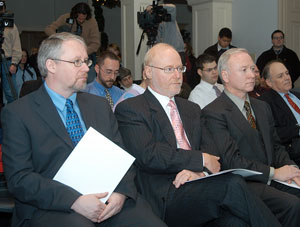December 8, 2004
Presidents on provincial funding agreement
by Catherine Young
 | ||
| Tom Traves was among the university presidents participating in Tuesday's announcement. (Wayne Lowther photo) | ||
The three-year funding agreement between the provincial government and Nova Scotia's universities will begin to close the gap between tuitions here and those in the rest of Canada, Dalhousie University President Tom Traves said Tuesday.
Dr. Traves said Nova Scotia universities make a very credible case that they offer the best educational opportunities in the country, and with increasingly competitive tuition fees, the future is bright.
The agreement takes effect at the start of the next fiscal year (April 1, 2005) and runs through fiscal 2007-2008. The province will increase the operating grant paid to universities by 5.8 per cent in the first year, 5.2 per cent in the second year and 4.5 per cent in the final year of the agreement. Tuition increases, for most programs, will be held to 3.9 per cent or less in each of those three years. Some programs are excluded from the tuition ceiling, notably medicine, dentistry and law and international student differential fees are excluded from the terms of the agreement.
Dalhousie will see its annual government grant increase by approximately $17 million by 2007-2008, an increase of about 12 per cent over the current year's (2004-05) grant of about $107 million. The university's annual operating budget exceeds $217 million, so the provincial grant accounts for less than half.
Dr. Traves said the three-year funding agreement is "welcome news" for Dalhousie and its students, as it is for all Nova Scotia's universities.
"The provincial government's commitment to fund universities at a level that reflects our real cost increases represents a major step forward in our relationship.
"We are still in conversation with the province about desired increases in capital spending and research support," he said, noting that those issues will be dealt with separate from the MOU.
Dr. Traves also sounded a note of caution.
He said that while the increased funding stabilizes the budget over three years, the need for financial constraint remains.
"For the next three years, we will have larger government grants and revenue from tuition will grow much more slowly. The new agreement is very welcome because it means more public support and less burden for students. Our overall budget picture, however, features the annual struggle to reconcile a host of pressing needs with limited resources."
"We will still have to make hard choices among many worthy objectives."
Accordingly, Dr. Traves said the standard budget process will obviously proceed, and the Budget Advisory Committee after consultations with the university community will be expected to develop a balanced budget proposal.
"The result, as usual, may see some spending areas cut and others increased."
Dalhousie Student Union President Curtis McGrath was generally pleased with the funding announcement.
"It's a step in the right direction. The Department of Education is bringing a substantial sum of money to the table to help alleviate some of the challenges all the universities face in terms of their operating budgets."
Mr. McGrath said the tuition ceiling gives students needed relief. "A 3.9 per cent increase is better than a 7.7 per cent increase, which is what we expected in the absence of a Memorandum of Understanding. We view that as positive."
He did, however, express reservations. "Tuition fees in Nova Scotia are, on average, $5,984 while the national average is $4,127. So this year, Nova Scotia students will pay about $1,800 more than the national average. That's unacceptable. The provincial government, university presidents and students all need to work together to address this gap."
Mr. McGrath said he has serious concerns about the exclusion of professional students, such as medical, dental and law students and international students, from the agreement. "My concerns are that these designated groups will bear the brunt of any increased operating expenditures in the coming years."
He said university funding should be examined from a public policy point of view. "The 11 universities of this province represent a $1 billion industry, creating 7,500 high-quality, well-paying jobs and 17,500 indirect jobs. We have the largest number per capita of post-secondary institutions of any province in Canada. It is time that the Nova Scotia government viewed the university sector as an investment in Nova Scotians' well-being, rather than as an expenditure.
"The exclusion of international students from tuition caps also flies in the face of the province's immigration strategy to attract more skilled workers to the province," he said. "Finally, the equalization payments formula has been revised and Nova Scotia has received an additional $132 million dollars. This should enable the government to be more attentive to the rising costs of post-secondary education in the province."
